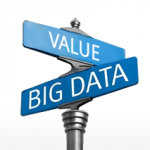Finding Value in Data

 If you ask 100 people to define the value that data brings an organization, you’ll most likely get 150 different answers. Yes…that’s right…150 answers. You’ll hear a few good succinct responses but most will give you a few different answers with examples of how their organization ‘uses’ data.
If you ask 100 people to define the value that data brings an organization, you’ll most likely get 150 different answers. Yes…that’s right…150 answers. You’ll hear a few good succinct responses but most will give you a few different answers with examples of how their organization ‘uses’ data.
There’s a problem with that response though. Using something doesn’t mean it has value. Doing data analysis isn’t delivering value; its just doing data analysis.
The value of data comes from the purposeful analysis of that data. Additionally, you can’t analyse data and hope to find value without an idea in mind of where that data comes from (i.e., context) and how you hope to be able to use that data (i.e., strategy).
Approaching data analysis without context and strategic purpose is similar to getting on the highway with a full tank of gas and driving without a destination in mind. Sure, you’ll get somewhere but you won’t really know if that ‘somewhere’ is the ‘right’ place.
A caveat to the contextual and strategic aspect of data analysis is that if you are ‘doing’ big data the right way, you should find more questions than answers. Your strategic thinking and data context should continue to drive the analysis and use of data within the organization but you should be willing to take whatever questions and answers you find.
Some people would argue that part of data science and big data is finding new questions and insights that you didn’t know you were looking for. In fact, you never really know what you’ll find when you start digging into data; but there’s a difference in digging into data without some sort of roadmap and purposefully analysing data. If you don’t have some form of strategy behind your analysis, you won’t really know when you’ve found something of importance.
There is value in data but the real, long-term value of data comes not from just the data itself but from the purposeful analysis of that data.


Comments ()